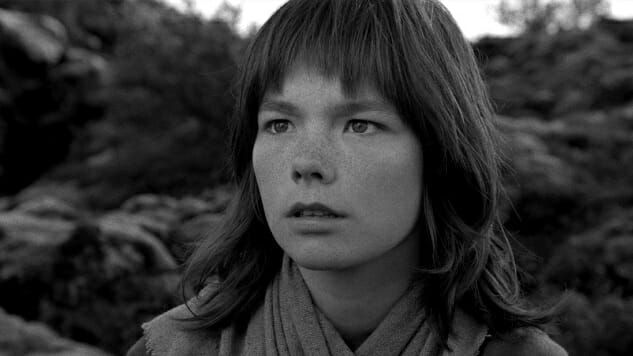Iceland’s the rare country whose fairy tales could conceivably be real. Every country has folklore, of course, but not every country is built on a landscape like Iceland’s, haunted and alien at once: Reynisfjara’s black sand beach, with its asymmetrical cliffside rock formations; Þingvellir’s eerie, too-quiet valley of rifts and waterfalls; the grand, mighty Gullfoss.
If the legends of any culture turn out to be true, they’ll be Iceland’s. For proof, just watch the opening moments of The Juniper Tree, the debut feature from Boston-born filmmaker Nietzchka Keene and the first screen role of Icelandic singer Björk; the film premiered at Sundance in 1990, but only now is getting its theatrical due in the United States. Keene’s camera, guided by Randy Sellars, focuses on a fair-haired child tending a humble grave nestled against a stone wall’s staggered obsidian pitch. The boy is dwarfed by his surroundings. He’s unobtrusive as he makes his quiet vigil, so still at first that the shot looks like a freeze frame. Nature dominates, serene but forbidding at the same time.
Keene and Sellars carry that theme by cutting to Margit (Björk) leaning against a boulder towering over her. The scope of nature suggests fantastical grandeur: Iceland is not humanity’s domain. They just pay rent there. They kill each other, too, as Margit and her older sister, Katla (Bryndis Petra Bragadóttir), are reminded when they happen upon a waterlogged corpse floating face down in a puddle. “They stoned her and left her for the ravens,” explains Katla in monotone. “Who was she?” asks Margit, the compassionate sibling. Katla doesn’t know. She may not care, either. She’s trying to stay alive, and Margit with her, bewitching the widower Jóhann (Valdimar Örn Flygenring), over the objections of his son, Jónas (Geirlaug Sunna Þormar), in a bid for shelter and sustenance.
Margit’s and Katla’s mother has been stoned and burned for witchcraft, leaving them in need of a place to call home. Like the woman in the pool, her life has been taken by man and her remains have been claimed by the earth. The Juniper Tree establishes humans’ insignificance in the scope of the natural world immediately. All that any of the characters can really hope to do is endure.
The Juniper Tree is based on the fairy tale of the same name, collected by the Brothers Grimm but adapted into a narrative befitting the merciless beauty of Iceland’s environment and its brutal heritage. Maybe Keene could have told the story by changing nothing, and maybe The Juniper Tree would have worked as a film anyways. But when Keene shot it in the summer of 1986, she recognized Iceland’s otherworldliness and saw how the narrative could be hardened to suit the unforgiving climate. Here, there are no happy endings. People either perish in the elements or survive in whatever way they can.
Granted, thanks to child decapitation and matricide, the original fable is not exactly sunshine and rainbows, either. But the child comes back to life, the wicked stepmother gets what she deserves, and everyone left uncrushed by millstones has lunch. Keene’s version denies viewers even a hint of succor. Margit lives. Katla runs off. Jóhann lives, too, but Jónas takes a cliffside slip that leads to a freefall, and the freefall to his demise; Katla cuts off the dead boy’s finger, puts it in his mouth, sews his lips shut, and sends him floating downriver like a medieval Pennywise. Jónas doesn’t get a second chance. Like all of the dead in The Juniper Tree, he’s absorbed into nature.
Keene’s eye for composition and evident respect for Iceland and its stark geographic allure has yielded a film as gorgeous as it is barbaric, a black-and-white masterwork. Restored by the Wisconsin Center for Film & Theater Research, funded by the George Lucas Family Foundation, The Juniper Tree demands new appreciation now that it’s been released into the wild for the first time since winning over Sundance crowds nearly 30 years ago. It’s a perfect marriage between artist and location, with Keene leveraging Iceland’s harsh expanse to dreadful effect.
It’s also one of only three movies Keene got to make, a tragedy unto itself. Keene died in 2004 before she could finish her third, Barefoot to Jerusalem. (Third parties managed to complete it in 2008.) With The Juniper Tree given the 4K treatment, viewers now get to see what was and what might have been had Keene lived. But with The Juniper Tree, she’s left behind an impeccable piece of cinema history as her legacy, waiting to be discovered by audiences denied the chance to experience it themselves.
Director: Nietzchka Keene
Writer: Nietzchka Keene
Starring: Björk Guðmundsdóttir, Bryndis Petra Bragadóttir, Guðrún Gísladóttir, Valdimar Örn Flygenring, Geirlaug Sunna Þormar
Release Date: March 15, 2019
Boston-based culture writer Andy Crump has been writing about film and television online since 2009 (and music since 2018). You can follow him on Twitter and find his collected writing at his personal blog. He is composed of roughly 65% craft beer.
